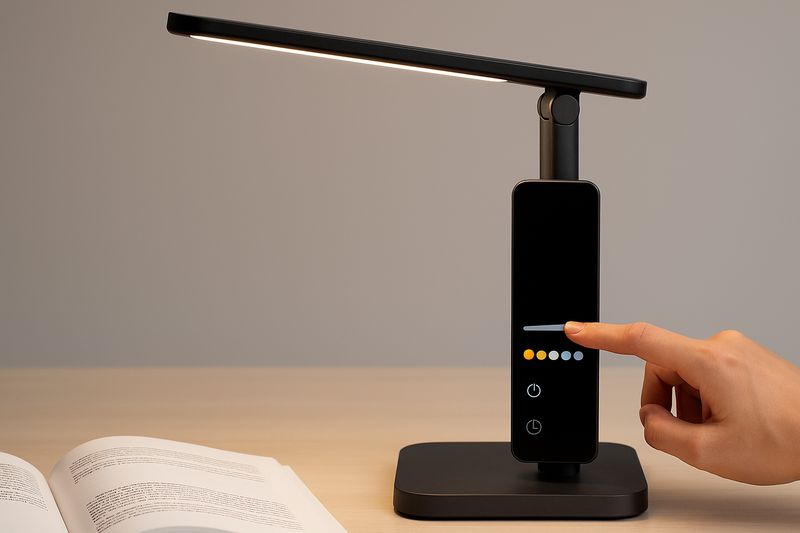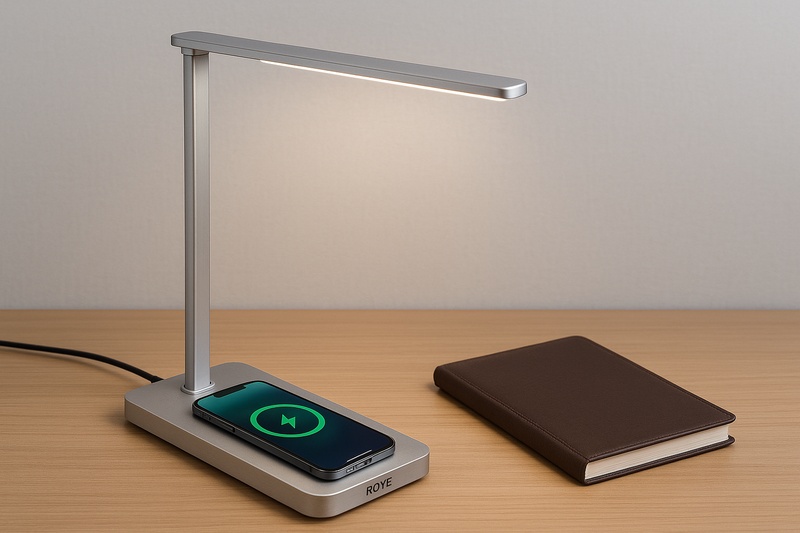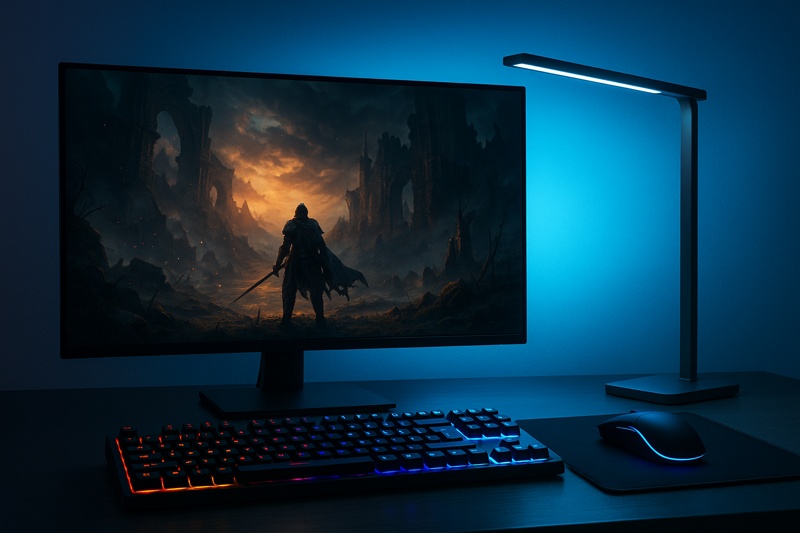
You're searching for an "eye-caring" desk lamp, but the choice between "warm light" and "cool light" is confusing and stressful. Choosing the wrong one could mean ending up with persistent eye strain, headaches, and even disrupted sleep, defeating the whole purpose of your purchase.
Warm light is best for relaxation and evening use as it promotes sleep, while cool light is superior for daytime focus and detail-oriented tasks. The ultimate eye-caring lamp isn't one or the other; it's one that offers both.
Let's explore the science behind these light types so you can choose the right light for the right time, creating the perfect environment for both productivity and health.
Is Cool Light the Secret to Unlocking Daytime Focus?
You're trying to concentrate on a detailed report or study for an exam, but your mind keeps wandering and a wave of sleepiness hits you mid-afternoon. This frustrating dip in energy kills your productivity and makes it impossible to focus on the task at hand, forcing you to re-read the same sentence over and over.
Cool white light (4000K-5500K) is a powerful productivity tool. By mimicking the properties of natural daylight, it suppresses the sleep hormone melatonin, boosting your alertness and making it the perfect choice for analytical, detail-oriented work.

At Royelamp, we see this principle in action all the time. I was recently working with an architectural firm to outfit their new studio. Their main requirement was lighting that would keep their team sharp and allow them to see the finest details on their blueprints and computer models for hours on end. A warm, cozy light would have been a disaster, creating a sleepy, low-energy environment. We equipped each workstation with our lamps set to a crisp 5000K. The feedback was immediate. They reported a noticeable reduction in the "afternoon slump" and said the sharp, high-contrast light made spotting errors on complex drawings significantly easier. This is the power of cool light: it’s an active tool that signals to your brain that it's time to be awake, alert, and engaged. It’s less about comfort and more about performance.
The Science of Staying Awake
Your body's internal clock, or circadian rhythm1, is heavily influenced by light. Specialized cells in your eyes contain a photopigment called melanopsin2, which is particularly sensitive to the blue-light wavelengths present in cool white light. When these cells detect blue light, they send a signal to your brain to stop producing melatonin, the hormone that makes you feel drowsy. This is the same reason you feel more awake on a bright, sunny day. Cool light essentially brings the alertness-boosting effects of noon-day sun right to your desk.
When to Use Cool Light
This type of light isn't for every situation, but it is the undisputed champion for specific tasks that demand high levels of concentration. It excels at making text and lines appear sharper and more defined. This high contrast is crucial for activities where precision is key. It helps your eyes easily distinguish details, reducing the cognitive load on your brain and helping you stay focused for longer periods without feeling fatigued.
| Task | Recommended CCT | Why Cool Light Works Best |
|---|---|---|
| Studying or Research | 4500K - 5500K | Boosts alertness and helps with memory retention. |
| Proofreading / Editing | 5000K - 6000K | Creates high contrast, making text and errors easier to spot. |
| Crafting / Drafting | 5000K - 6500K | Renders colors and fine details with high accuracy and clarity. |
| Video Conferencing | 4000K - 5000K | Provides a clean, professional light that prevents a yellow or drowsy look. |
Is Warm Light the Key to Relaxation and Better Sleep?
You love to read a book or journal in the evening to unwind, but the harsh, intense light from your lamp leaves your eyes feeling tired and wired. When you finally turn it off and try to sleep, your mind is racing, and it takes forever to drift off, leaving you groggy and unrested the next day.
Warm light (2700K-3000K) is essential for eye comfort and health in the evening. Its soft, amber glow contains very little blue light, allowing your brain to produce melatonin naturally, which signals that it's time to rest and leads to a better night's sleep.

This is something I'm very passionate about on a personal level. As a marketing manager in the lighting industry, I'm surrounded by the science of light all day. But as a mother, I see the real-world effects at home. For years, my children's bedside lamps had standard, cool-toned bulbs. They would read before bed but then have trouble settling down. After switching their lamps to ones with a warm-light setting, the change was incredible. The soft, gentle light created a calm environment. Within a week, their bedtime routine became smoother, and they fell asleep more easily. It's not magic; it's biology. The absence of stimulating blue light tells the body's internal clock that the day is over. For adults, this effect is just as powerful for de-stressing after a long day and protecting our natural sleep cycles from the interference of artificial lighting.
Protecting Your Circadian Rhythm
The blue light that is so helpful during the day becomes a problem at night. Continued exposure in the hours before bed tricks your brain into thinking it's still daytime, severely disrupting your circadian rhythm3. This can lead to difficulty falling asleep, lower-quality sleep, and even contribute to more serious health issues over time. Warm light is "eye-caring" in the evening precisely because of what it lacks: stimulating blue wavelengths. It provides illumination without sending a "wake up" signal to your brain.
More Than Just Sleep: The Psychology of Comfort
The benefits of warm light4 go beyond the physiological. It has a powerful psychological effect, creating a feeling of coziness, safety, and relaxation. Think of the warm glow of a fireplace or a candle; this is the atmosphere that warm light emulates. It's the perfect choice for non-task-oriented activities where comfort is the primary goal. It transforms a space from a functional work area into a personal sanctuary, helping to reduce stress and anxiety at the end of the day.
| Evening Activity | Warm Light Effect (2700K) | Cool Light Effect (5000K) |
|---|---|---|
| Reading for Pleasure | Gentle on the eyes, promotes relaxation. | Harsh glare, can cause eye strain and keep you awake. |
| Journaling/Winding Down | Creates a calm, meditative atmosphere. | Feels sterile and stimulating, hindering reflection. |
| Talking with Family | Fosters a cozy, intimate environment. | Can feel like an interrogation room, too intense. |
| Pre-Sleep Routine | Allows natural melatonin production for easy sleep. | Suppresses melatonin, making it difficult to fall asleep. |
Is Your "Eye-Care" Lamp Just a One-Trick Pony?
You bought a desk lamp that was heavily marketed as "eye-caring," but you find it's only good for one thing. It has a single, fixed color temperature—maybe a nice warm glow or a crisp cool light. But when you try to use it for different tasks or at different times of day, your eyes still end up feeling strained and uncomfortable.
The biggest myth in the lighting industry is that a single color temperature can be "eye-caring." True eye care isn't about choosing warm or cool light; it's about having the flexibility to adapt your light to your specific needs at any given moment.

I speak with buyers every single day, and the most common mistake I see is the search for a single "perfect" light. They'll ask me, "Is 4000K the best for eyes?" The truth is, that's the wrong question. It's like asking if a screwdriver is the best tool. It's great for screws, but useless for hammering a nail. I recently worked with a large university that was looking to equip its new dorm rooms. They were initially considering a simple, fixed 3500K lamp as a "one-size-fits-all" solution. I argued that this would be a huge disservice to the students. A student's desk is their entire world; it's where they study for exams, write papers, read for pleasure, and video chat with family. They need cool, bright light for intense studying but warm, dim light for relaxing before bed. We convinced them to invest in our fully adjustable models. The feedback from students was overwhelmingly positive, praising the ability to change the light to fit their activity.
The Pillars of a Truly Eye-Caring Lamp
A fixed lamp, no matter how high-quality, is a compromise. A genuinely adaptive and eye-friendly lamp must have a combination of features that work together. Relying on just one is not enough.
1. Adjustable Color Temperature (CCT)5
This is the most critical feature. The ability to shift from a 5500K cool white for daytime work to a 2700K warm glow for evening reading gives you complete control over your environment and its effect on your body's circadian rhythm.
2. Full-Range Dimming
Just as important as color is brightness. The ideal brightness changes depending on the ambient light in your room and the task at hand. A lamp that is too bright creates glare and eye strain; one that is too dim forces your eyes to work harder. Stepless dimming allows you to find the perfect level of illumination, creating the ideal contrast with your screen or paper.
3. High Color Rendering Index (CRI > 90)6
CRI measures how accurately a light source reveals the true colors of objects. A low-CRI light makes colors look washed out and dull. This forces your brain to work harder to process visual information, leading to subconscious eye strain. A high-CRI light (over 90) renders colors vividly and naturally, making the visual experience more comfortable and less fatiguing.
| Feature | Fixed "Eye-Care" Lamp | A Truly Adaptive Lamp | Why it Matters for Eye Health |
|---|---|---|---|
| Color Temperature | One fixed setting (e.g., 4000K) | Fully Adjustable (2700K-6500K) | Matches light to your body's needs (alertness vs. relaxation). |
| Brightness Control | Often limited (e.g., 3 steps) | Full-Range Stepless Dimming | Eliminates glare and provides perfect contrast in any environment. |
| Color Rendering | Often unspecified (CRI ~80) | High Fidelity (CRI > 90) | Reduces cognitive load and strain by showing true, natural colors. |
Conclusion
For complete eye care, don't choose between warm or cool light. Choose a lamp that gives you both.
-
Understanding circadian rhythm can help you optimize your sleep and wakefulness, enhancing your daily productivity. ↩
-
Exploring melanopsin's function can provide insights into how light influences your alertness and overall health. ↩
-
Understanding circadian rhythm is crucial for improving sleep quality and overall health. Explore this link for in-depth insights. ↩
-
Discover how warm light can enhance your living space and promote relaxation, making it essential for your well-being. ↩
-
Explore how Adjustable Color Temperature can enhance your lighting experience and support your circadian rhythm. ↩
-
Learn why a High Color Rendering Index is crucial for reducing eye strain and improving color perception. ↩







